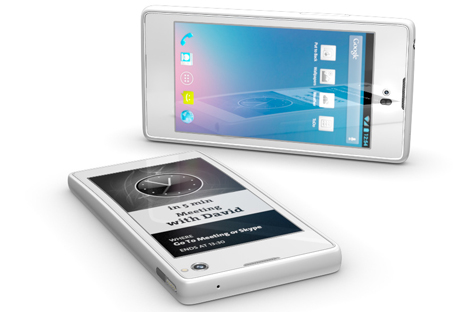Yota to entice Indian users with design and smart technology

YotaPhone, Russia's first smartphone from a Russian company has won a Best of Consumer Electronics Show award from CNET.com. The smartphone will be launched in India in 2014. Source: www.yotaphone.com
By entering India’s emerging LTE (long-term evolution) market, YotaDevices hopes to grab a significant piece of the pie even though its products fall into the premium segment.
“The reason why we initially got into this business was that we were not very happy with the design, the quality and the ‘out of box experience’ with the devices coming from China,” says YotaDevices COO Lau Geckler. “And we started developing products very much focused on nice design and a very solid out-of-box experience: it takes the consumer only 10-15 seconds from the time he actually takes the new device from the box to the time he connects to the network.”
YotaDevices was formed in 2010 as a separate manufacturing unit of Russia’s first and only LTE telecom provider Scartel, operating under Yota brand.
Yota started in 2007 as WiMAX-based broadband internet provider but later switched to LTE network. In 2012 Russian billionaire Alisher Usmanov bought Yota’s telecom business in 2012, manufacturing start-up was taken over by a group of investors.
To promote its products in India, YotaDevices partnered with Indian CDMA devices manufacturer Olive Telecom, the main CDMA dongles supplier for Tata DoCoMo and MTS India. YotaDevices is not the first Russian partner of Olive Telecom, which has Russian-speaking expats in its management board. Olive’s CDMA devices have been marketed in Russia by telecom operator Skylink for the past several years.
“The advantage of Yota’s devices is design – you can feel the difference once you take it in your hand. The performance of Yota’s modems is better due to different antennas and better materials used. The software solution developed in Russia allows decrease time and efforts the user spends on connecting the device. This also helps mobile operators reduce time and cost of support per customer”, says Artem Orange, President Operations at Olive Telecom.
India is one of the first markets on YotaDevices’ expansion roadmap. The company started negotiating outside Russia only a year ago focusing primarily on European markets. “We have few deals in Asia too - Singapore, Japan, Australia, India. Basically these are the countries with high LTE penetration. But the first real deals will be coming from Russia and India hopefully,” Geckler told RIR.
Till date, YotaDevices has sold around 3 million LTE devices, accounting for 6 percent market share of the global LTE device market. Most of the devices were sold in Russia, however last year around 40 percent of the company’s business was outside Russia, according to Geckler.
Investing in the future
LTE networks were launched by only one carrier so far in India and the number of LTE subscribers is only in the tens of thousands. Entering quite a narrow but promising segment of the Indian telecom market, YotaDevices expects significant growth of the Indian LTE market along with the device segment.
“The operators are willing to invest in base stations and also in proper modems and routers so I see a lot of prospects at this market in India. If you look at 3G development in India and the volumes behind it, you will see a huge business opportunity. There is no doubt that Indian operators are preparing to fight on the LTE market as well,” Geckler says.
Timur Nigmatullin, Investcafe analyst agrees that Indian LTE devices market is currently an upcoming market: “It reminds of 3G modems market in Russia in early 2000s. So I expect the demand for such devices will be growing significantly.”
Geckler adds that YotaDevices has already invested quite a lot in entering Indian market as it had to develop a special product line for India because technically 4G networks and thus devices differs in Indian and Russia. “So we now have quite high ambitions, but it depends on telecom operators a lot”, he adds.
According to YotaDevices and Olive Telecom management, the partners are in talks with all major LTE licensees that are in the process of establishing LTE networks in India. However, industry sources said apart from a one-time proposal there were no further negotiations going on with major LTE players.
Related:

Made-in-Russia smartphones to go global
After 4G deal with Reliance, Russia’s SPIRIT bullish on India
LTE on the shelves
Yota’s devices may appear on the shelves by October-November 2013. The Russian vendor is positioning itself in the premium market, being slightly costlier than Chinese vendors which Yota considers as the main competition both in India and globally.
Chinese giants Huawei and ZTE have already secured their strong positions in the price-sensitive Indian market. Till date, the only telecom operator offering LTE device in India is Bharti Airtel having 4G networks established in Kolkata, Bangalore, Pune and Chandigarh. The carrier offers its 4G LTE USB dongles and routers at the price of about $84 and is looking for reducing the price in future.
Another big player in Indian 4G LTE market Reliance Jio Infocomm is planning to launch 4G services for both data and voice within this year. Samsung and Datawind were named among devices vendors that are expected to work with Reliance Jio to introduce affordable 4G enabled devices in the market.
Industry experts believe India is the largest among lesser developed LTE markets in terms of data traffic and smartphone-penetration. “The data accounts for only 15 percent in average revenue per user (ARPU) for Indian carriers while globally it is 36 percent of ARPU on average. The penetration of smartphones in India is 6 percent compared to a global average of 28 percent. Thus India offers high prospects in terms of sales of modems and routers as LTE will influence the data market growth,” Nigmatullin of Investcafe says.
Huawei introduced its first LTE smartphone Ascend P1 LTE in partnership with Bharti Airtel and Qualcomm in 2012. “Though LTE smartphones are still not in the market at the large scale. Maybe in the second half of 2013 we will see more developments, but it largely depends on the operators and their ability to toll-out 4G networks and secondly on the adoption of LTE technology by Indian users ,” Huawei spokesman Suresh Vaidyanathan says.
ZTE, too, announced its decision to shift focus from telecom equipment to smartphones. “As per the latest IDC report the Indian smartphone market grew 74 percent year-on-year from 2012 Q1 to 2013 Q1. With the deployment of 4G, the device sector is likely to see additional growth,” a ZTE spokesman says.
He adds that India is a very competitive market amongst both international and the local vendors. Apart from this there are many local players mushrooming along with consumer electronics companies foraying into the device sector.
Nacheeket Nilekar, Director of Sales - India at Cadyce, Indian manufacturer of wide range of digital devices believes that 4G LTE will be the superior alternative for Indian businesses. “Currently our travel router CA-WTR150 supports 3G/4G and we are planning to launch some new LTE enabled routers and modems in coming days”, he adds.
“There are few companies in India but their main focus is 3G, it looks like most companies taking more matured technology which requires probably less capital investments. But I have not seen any local competitors who provide LTE devices at our quality”, YotaDevice COO Geckler says.
Apart from modems and routers YotaDevice is eyeing the smartphone market. Recently the company launched announced YotaPhone, an Android smartphone equipped with an electronic-paper screen on the back in addition to a standard touch screen on the front. The sales of this smartphone priced at around $USD 650 will start by the end of 2013 globally.
“The smartphone will be launched in India too, but later in 2014, I believe,”Artem Orange told RIR. However, Geckler points out that the YotaPhone would be a very expensive product for the Indian market. He adds, though, that considering the volumes of Indian market even a small chunk of consumers that would be interested in purchasing YotaPhone is something that company considers very interesting.
All rights reserved by Rossiyskaya Gazeta.
Subscribe
to our newsletter!
Get the week's best stories straight to your inbox